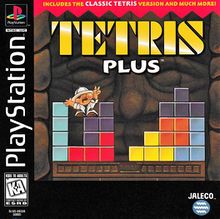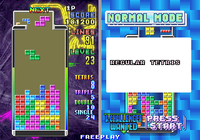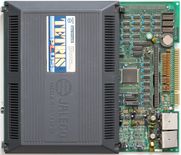Tetris Plus
| Tetris Plus | |
|---|---|
 | |
| Developer(s) | Jaleco Inc. |
| Publisher(s) | Jaleco Inc. |
| Platform(s) | Arcade, Game Boy, PlayStation, Sega Saturn |
| Release | Arcade:
|
| Sequel | Tetris Plus 2 |
| Gameplay info | |
| Next pieces | 3 (Normal, non-GB) 2 (Normal, GB) 2 (Puzzle, VS) |
| Playfield size | 10×20 (Normal, non-GB) 10×17 (Normal, GB) 10×15* (Puzzle, VS) *See main article for details |
| Hold piece | No |
| Hard drop | No |
| Rotation system | Identical to Sega Rotation, except the 3-cell wide tetrominoes spawn rounded to the right |
Tetris Plus[a] is a Tetris variant produced by Jaleco in 1995 for their Jaleco Mega System 32 arcade hardware. In 1996 ports were released for the Sega Saturn and PlayStation, as well as a Game Boy version. The game includes two single player modes, Normal Mode and Puzzle Mode, as well as a two player VS Mode which plays like a competitive version of Puzzle Mode. A sequel, Tetris Plus 2, was released in 1997.
On November 1st, 2019, it was re-released on the AtGames Legends Ultimate Arcade.
Gameplay
Normal mode

This mode is described in the selection menu as "Regular Tetris", and plays similar to SEGA's 1988 version, with a speed curve which rises and falls.
To either side of the playfield is a pair of bars which slowly rise with the passage of time; clearing lines will fill the bars more rapidly. When the bars are completely full, the next tetromino locked will advance the player a level and empty the bars.
The amount of points awarded for line clears increases linearly from level 1 to level 10, and stays capped at 10.[scoring 1]
- single: 100 × level points
- double: 400 × level points
- triple: 800 × level points
- tetris: 1600 × level points
- ↑ The scoring for level 0 is the same as for level 1.
| Level | Easy | Normal | Hard | Hardest |
|---|---|---|---|---|
| 0 | 50 | 50 | 50 | 50 |
| 1 | 25 | 20 | 16 | 16 |
| 2 | 20 | 14 | 10 | 10 |
| 3 | 16 | 8 | 7 | 6 |
| 4 | 20 | 15 | 16 | 12 |
| 5 | 14 | 8 | 8 | 8 |
| 6 | 8 | 6 | 5 | 5 |
| 7 | 6 | 4 | 3 | 2 |
| 8 | 16 | 10 | 8 | 8 |
| 9 | 10 | 6 | 5 | 5 |
| 10 | 8 | 4 | 3 | 3 |
| 11 | 4 | 3 | 2 | 2 |
| 12 | 12 | 6 | 8 | 8 |
| 13 | 8 | 4 | 5 | 5 |
| 14 | 6 | 3 | 3 | 3 |
| 15 | 3 | 2 | 2 | 2 |
| 16 | 6 | 2 | 4 | 3 |
| 17 | 5 | 2 | 3 | 2 |
| 18 | 4 | 2 | 2 | 2 |
| 19 | 3 | 2 | 2 | 2 |
| 20 | 3 | 2 | 2 | 1 |
| 21 | 3 | 2 | 2 | 1 |
| 22 | 3 | 2 | 2 | 1 |
| 23 | 3 | 1 | 2 | 1 |
| 24 | 3 | 1 | 1 | 1 |
| 25+ | 2 | 1 | 1 | 1 |
- Lock delay remains constant at 15 frames.
- DAS has an initial delay of 10 frames, and a repeat rate of 20Hz.
Puzzle mode
Puzzle mode involves clearing lines to get a professor to the bottom of the playing field.
The player gets a time bonus based on the clear time. The maximum bonus is 20000 points (corresponding to 10 seconds or less) with 100 points subtracted for every 1/4 second over 10 seconds.
Vs. mode
Initial Playfield State
There's a Initial Playfield State Which cycles 10 Playfield States and loops. Does not persist after machine reboots. (marked x is professor's spawn location)
Playfield 1, |
Playfield 2 |
Playfield 3 |
Playfield 4 |
Playfield 5 |
Playfield 6 |
Playfield 7 |
Playfield 8 |
Playfield 9 |
Playfield 10, |
Depending on the console/machine, It has weird quirks around games, Only Game boy version gives a draw, (excluding game boy) Leaving no control results in a P1 Win (P2 win in console), (excluding game boy) Holding down results in a P1 Win.
Physical scans
See also
Notes
- ↑ Japanese: テトリスプラス, Hepburn: Tetorisu Purasu













